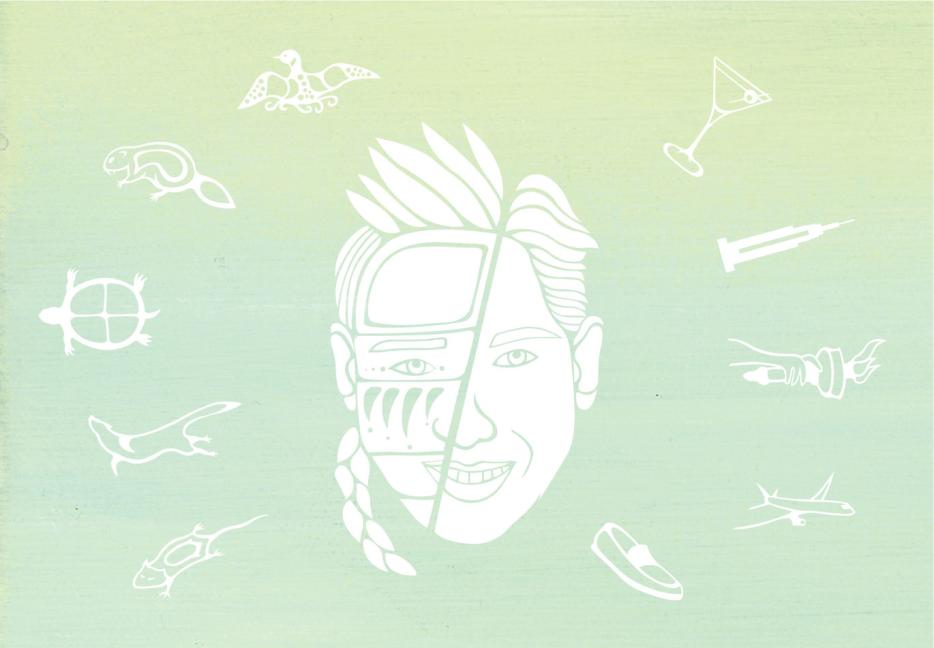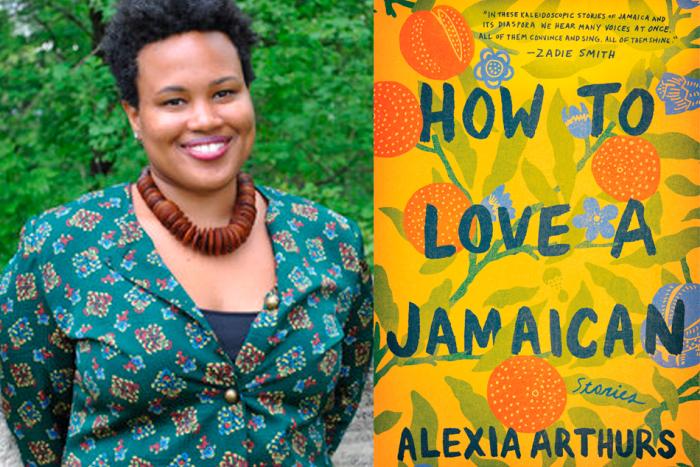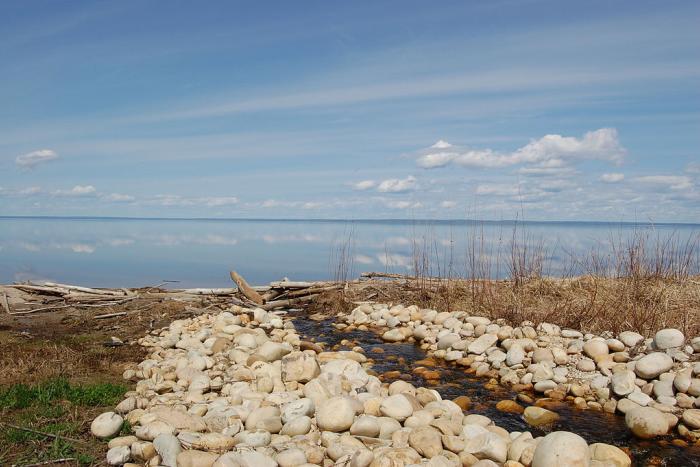I’m waiting in the detention room at the John F. Kennedy Airport in Queens, New York, in a very flashy, very out-of-context Prada runway look. I’ve just come back from Milan Fashion Week. The fluorescent lights buzz faintly overhead, as though to add to the dull energy of the room. An Indian man to my left continues to stare at my shoes. I wish I could say this is my first time here, but it isn’t. I’ve sat in this exact chair about five times.
“Allaire, Christian,” barks a TSA officer.
I get up and walk towards him. He gives me the Manhattan Once Over. (Note: The look catty fashion people give each other in New York City, starting by a judgment of your footwear and then everything upwards.)
“You don’t look Native American,” he says.
“I forgot my tomahawk at home,” I say to myself, in my head.
“Yes, I am First Nations,” I say to him, for real.
The TSA officer is holding a thin beige folder in his hands containing my Canadian passport, First Nations status card, and a letter from my reservation’s band office confirming my blood quantum. (In order to be considered a “Status Indian,” you must have at least fifty percent lineage.)
With these documents, I am able to work and live in the U.S.—as I have since 2014—through the Jay Treaty, an agreement signed in 1794 by representatives of the U.S. and Great Britain, which guaranteed Indigenous people the right to trade and travel between the U.S. and Canada (then, a territory of Great Britain). The Treaty still very much applies today—though it always seems to be news to TSA officers.
I brace myself for the long line of questioning.
“So you’re Native American, but from Canada?” he asks, taking a seat behind his desk, which sits on a raised platform like a pedestal.
“I’m First Nations, which is like Native-Canadian,” I say.
“If you’re Canadian, how do you live in America without a work visa?”
“I work in New York with my Native status card, through the Jay Treaty. I also have a Social Security number, and a letter from my company confirming I’m a legal resident.”
He tells me that I will need secondary security clearance before I can enter the U.S. This isn’t the first time. I quickly realize I’m not being barred entry for suspicious activity. I’m no terrorism threat. I’m being detained because—along with a recurring unfamiliarity with First Nations rights—the border patrol doesn’t believe I “look Native” enough to fit the profile, and they will need to further confirm my identity before I’m released.
I begin handing over the usual list of additional documents—a birth certificate, my social security card, proof of employment—while the TSA officer continues to stare at me. I pause and catch his gaze.
“Sorry,” he says. “I’ve never seen an Indian so pale.”
*
I was born into mixed heritage. My mother is First Nations, specifically from the Ojibwe tribe, which has roots in both Canada and the United States. My father, meanwhile, is a mixture of French-Canadian and Italian. (And in case you couldn’t guess, I inherited his fair complexion.)
I grew up on the Nipissing First Nation Native reservation in northern Ontario. While my mother and father lived off-reservation, my mother—one of eighteen siblings—spent her weekends bringing us to our grandmother’s home on the reservation, which served as the central meeting spot for our entire big, crazy, loud family. Every day after middle school, my sister and I would ride the school bus to one of our aunt’s homes on the reserve. The “rez,” as we call it, served as our second home. It still does.
Nipissing First Nation itself is divided into eight settlements of Indigenous land. Garden Village, the subdivision I grew up on, is located just southeast from Sturgeon Falls, the town where my parents now have a home. Running along Lake Nipissing, the homes in Garden Village span the beautiful waterfront and follow a single cement road that eventually turns into dirt. There, the pace of life begins to decelerate upon arrival. The days go by slow and the community gossip travels fast, and the mating sounds of cicadas in the summer heat outweigh any traffic noise.
Crossing the border—that is, the imaginary one—from off- to on-reserve land is obvious to those who do it regularly. “Are white people allowed on reserves?” a friend once asked me. There are no direction signs or toll booths. There is, instead, a slight shift in the details. During hunting season, slain game can be found hanging in garages, ready to be turned into meat pies or traditional Indian tacos. Some houses have bed sheets hung up in the window instead of curtains. Hidden pathways leading through wild bush reveal secluded beaches. Small billboards advertise cheap native cigarettes, available at the one convenience store where you’re bound to run into a cousin or two.
Though my mother’s family has always been comically tight-knit—most of our aunts and uncles live on the same central street—I grew up often feeling like an outsider on the reserve. For one, I didn’t look like my cousins. The hundred-percent, full-blown Indians. The “Rez kids.” I didn’t have their prominent cheekbones, or their dark skin, or their long braided hair. I didn’t hunt or dance in powwows. I didn’t speak their unique slang, like hollering “dewww!” after cracking a joke. I was a half-breed who wore weird gothic cargo shorts, and dreamed of moving to a bigger city.
Much of feeling like an outsider stemmed from my parents having their home on off-reserve land. Though I often crossed the border between off- and on-reserve, I never quite fit into either side. My sister and I went to a French-speaking Catholic school until high school. All of my friends were white. Most of the school was white. I, too, passed for white. In elementary school, a First Nations classmate of mine was being teased during recess time. She had a more traditional Indigenous look, with dark skin and very long, dark hair, sometimes worn in a braid. Our classmates surrounded her, hollering racist war whoops like caricatures in a bad John Wayne movie. I didn’t join in the malice, yet I didn’t come to her defense, either. I rarely acknowledged my Indigenous culture unless I was with my family. The imaginary border, as it turns out, created a very real divide.
*
The TSA officer begins typing on his computer while I continue waiting to be processed. I look around the humdrum room. Having been detained several times before, I’ve become too familiar with the room’s mundane staging. I know that I should sit to the left of the room, where the air conditioning is at least slightly more functioning. It’s the kind of place where joy and compassion come to die.
I recognize a few TSA officers here, mostly by their distinctively tired faces. Fellow travellers—or do I call them my cellmates?—sit dispersed around the waiting area of the detention room, some fidgeting anxiously in their seats, others appearing completely unbothered. We make up a sad group of border misfits. Minorities, unsurprisingly, fill the room. There are some Indian, some Chinese. No Caucasians.
The TSA officer opens the folder containing my travel documents.
“What is this?” he asks, holding up my status card.
“My status card,” I say.
“I’ve never seen one of these before. You could have made this yourself.”
Status cards are government-regulated identification cards, originally introduced by Indian and Northern Affairs Canada. Each Canadian-born First Nations person of at least fifty-percent lineage has a status card issued to them by their respective band government, and can use it to cross the border to and from the U.S. They can live and work, “freely,” in either country. They don’t need a green card, they don’t need proof of employment, and, technically, they don’t even need a passport. But I don’t dare try to tell him that part.
The idea of status cards first came into play during the early days of the Indian Act, originally introduced by the Canadian government in 1876. Prior to many revisions, the Indian Act, which aimed to assimilate indigenous people into “civilized” culture, actually used to restrict Natives from leaving their reservation without a permission slip. Indian agents—and yes, that was what they were actually called—would patrol the borders, sometimes armed, and could arrest anyone without a valid pass.
“Where are you travelling from today?” he asks.
“I’m coming from Milan. I was there for work,” I say.
“What type of work do you do?”
“I’m a fashion editor at a magazine. I was in Milan to cover fashion week.”
“What magazine?”
“It’s called Footwear News.”
“You work at a magazine about … shoes?”
The TSA officer leaves his desk to consult one of his TSA officer friends. As it turns out, neither of them have ever admitted a Canadian-born First Nations person into the U.S. before. I am what they call a “grey area.” I’m told to take a seat and wait, and that I will need higher security clearance from their supervisor before I can enter.
“I’ve lived in New York for three years,” I say, starting to lose my patience. “I cross the border almost every month. Don’t you have some sort of record?”
*
First Nations people don’t believe in crossing the border.
The notion of belonging to Canada or the U.S. is foreign to my people. In our culture, North America—or even more broadly, planet Earth—is seen as one entity, and one piece of land. We call it Turtle Island. (For the TSA, that means we don't fit in a box. And that's an automatic code red.)
There is no greater example of this than the Ojibwe creation story.
The legend begins with a great spirit called the Gitchi-Manitou a very long, long, long time ago. Looking out in the vast darkness of the universe, the Gitchi-Manitou created the earth and all of its elements. He created the animals, the trees, the water, the plants, the weather, the soil, the fire. Soon after, the Gitchi-Manitou also created the Anishinaabe people, too. The Anishinaabe are considered to be the first people, including tribes such as the Ojibwe, Odawa, Potawatomi and Algonquin people. (Meanwhile, other tribes, such as the Cree, have their own version of the creation story.)
When the Gitchi-Manitou created the earth, he envisioned the Anishinaabe people living together in complete harmony. And so they did.
But it didn’t last long.
The Anishinaabe people began fighting amongst each other. Greed sunk its teeth into each distinctive tribe, tightening its grip as great battles intensified over the desire for more land, more food and, ultimately, more power. The Gitchi-Manitou soon realized that the earth would need to be purified. The canvas he painted so beautifully would need to be wiped clean. And like any powerful force, he decided there could only be one way to do it: A great, disastrous, Hollywood blockbuster-type flood.
The earth was quickly and violently engulfed by water. The people and all of the elements drowned, along with the earth’s precious soil. Everything, that is, except the animals. A muskrat, a turtle, an otter, a beaver and a loon survived the great flood and floated together in the vast body of water, each taking turns to rest on a single floating log.
They were the only ones left.
They decided the only way to rebuild the earth would be to retrieve its sunken soil. If they each dove down to the bottom of the water and grabbed a handful of soil, they could begin covering the turtle’s shell with it, using it as a new makeshift island. (The idea wasn’t stupendously logical, but it was the only one they had.) And so they began.
The loon—a natural swimmer—tried his luck first. Taking a deep breath, he dove underwater and disappeared for several minutes, eventually re-emerging. “The bottom is too far down,” the loon said. “We’ll never reach it.” The beaver and the otter followed, each agreeing that the soil is too far down. The turtle, bearing a heavy shell on its back, didn’t even bother to attempt. That would be downright foolish.
Finally, it was the muskrat’s turn. He was the group’s last bit of hope, and they were running low on it. Taking a deep breath, the muskrat dove down in search of the soil. Several minutes went by—minutes that seemed eternally longer than everyone else’s minutes—and the group feared he drowned. They floated in silence. But just then, the muskrat re-emerged, weak and breathless. Opening his paw, he revealed a small handful of soil, which he poured onto the turtle’s back. The group cheered!
The wind suddenly began blowing from all four directions. The water rippled as though coming to a boil. It was the turtle’s shell. It was growing and growing fast, stretching itself from one end of the earth to the other. With it, the soil on its back spread out, too.
That’s how Turtle Island was formed. It took a great catastrophe, and for a group to learn how to work and cohabitate with each other, for the Gitchi-Manitou to restore all life back on earth. The Anishinaabe people were created again, and they, too, learned to live as one entity. (Needless to say, they learned from their ancestors’ mistakes.) A new world was born—call it the greatest second chance of all time—and it would be a world without segregation, greed or corruption.
It would be a new world without division.
*
It has now been about three hours spent in the airport detention room. The wall clock seems to exist solely to taunt me, the needle movingggg likeeeeee molasses. Some of my fellow detainees have missed their connecting flights and continue to wait. Nobody is allowed to use a cell phone. A couple tries to whisper something to each other, but are swiftly shushed by a TSA officer. I wonder how many other Indigenous people have sat in this chair. I remember my aunt telling me about her experience just a few months prior, where she was mistaken for another First Nations women of the same name who happened to be on a national no-fly list.
Needless to say, her luggage was searched.
The supervisor finally arrives. He is the man of the hour. The man standing between my freedom and my deportation. My imagination begins to run wild. I imagine myself having to book a flight back home to Canada, with a suitcase full of frivolous designer clothing that should never be worn outside of a fashion show venue. I think about my Upper East Side apartment in New York, and how I would have to coordinate moving all of my furniture and belongings. I think about the low-maintenance plant I had just bought. Who would water it? Would it just wither and die, like my career? I was pissed. What about my shoes?
The supervisor enters the room at a hurried pace and sports a different colored badge than his peers. I make a note that he appears to be Italian. Thank god, I think, that we have something in common. He seems to makes the room nervous—not just the detainees, but the immigration agents, too. For a second I think he is holding a gun in his hands, but then I snap out of my paranoia. It will be fine, I tell myself, even though my heart is pumping faster than the heart of someone on a three-day speed binge. Instead of aiming a pistol at me, he unexpectedly flashes me a kind smile instead.
“Let’s see what we have here,” the supervisor says, gesturing for me to come to the front of the room. “Native American entry?”
“He says he’s Native American, but he’s born in Canada,” the TSA officer says.
“No,” I say, “First Nati—”
“Sorry, he’s ‘First Nations,’” the TSA officer says, emphasizing the air quotes.
They discuss which immigration section I fall under, as though I am not in the room. The supervisor admits that they haven’t admitted a First Nations person “in a while.” I wonder what “a while” is. He gives me the same look of doubt the TSA officer has been giving since I got here—the “is he really Native, though?” look—and just when I think he’s about to give me the bad news, he closes the folder containing my documents.
“We’ll file this under 289,” the supervisor finally says. (I learn that my immigration status falls under that section number of the Immigration and Nationality Act, which reads, simply, that, “Nothing in this title shall be construed to affect the right of American Indians born in Canada to pass the borders of the United States, but such right shall extend only to persons who possess at least 50 per centum of blood of the American Indian race.”)
The supervisor stamps my passport and hands me my documents. He tells me I am free to go. Did I hear him right?
“What?” I ask.
“Welcome home,” he repeats.
I grab my bag and compile my documents. The conclusion seems jarringly anticlimactic. That’s it? Moments ago I feared deportation, and now I’m being welcomed home with open arms. Do I get a complementary Mai Tai, too? That’s just the beauty about being First Nations at the border: you never know if you’ll be waved through or strip-searched.
As I head out of the detention room, I thank the supervisor for his time.
“You said you’re Ojibwe?” he asks.
“Yes,” I say.
“Interesting,” he pauses. “I thought your people were all dead.”
*
After being cleared from immigration, I finally leave the detention room. I feel like, and look like, a caged animal set free. I immediately check my phone. I have a few missed calls from my boss at work. Multiple worried text messages from my parents and friends asking if I’ve landed safely. In a haze, I make my way down the airport’s dizzying route of escalators. I move past the excited tourists and the crying toddlers. I arrive at the baggage claim area, where my suitcase is circling the empty carousel.
Outside, the airport is the busiest I’ve ever seen it. Just what I need! There is a long queue for taxis that winds and coils and coils and coils. I begin the wait. I fire off some e-mails about the top runway shoe trends from Milan, a topic that feels comically trivial compared to my almost-just-getting-incarcerated moment. I had planned to go straight into the office when I landed, but business hours have now come and gone. (Thank god.)
Finally, I get inside a taxi. On the radio, they are debating Donald J. Trump’s refugee travel ban. I politely ask the driver to change the station.
“How was your flight?” he asks me, as we begin the ride.
“Truthfully, not well,” I say. “Got held at the border for a while.”
“Ah,” he chuckles. “Happens to me every time I travel.” He is Muslim.
We begin driving toward the city. We cross a toll booth. We cross a “Welcome to New York!” sign. We cross a bridge. The irony isn’t lost on me here; we seem to spend our whole lives crossing borders. And not just the kind at airports. As cultural groups and as distinct human beings, we are constantly transitioning from one thing to the next, overcoming divisive hurdles and entering new territory as a result.
For First Nations people, we have yet to come out on the other side. We are not here, nor there. Where we fit into modern society remains undefined. Today, geography is no longer allowed to be fluid. Some of us live traditionally on our secluded reservations. Some of us have fought our way to big cities, or other countries, finding new ways to connect with our culture. Should we have to choose? It’s as though we are stuck in an endless waiting room; we are waiting for someone to call our name so we can move forward, but the only ones calling our name are ourselves.
We roar across the Triborough Bridge at a deathly speed that is typical of a New York City taxi. But I am hardly paying attention. I’m almost at my apartment. I open the window for some fresh air. As we are approaching the city skyline, I can’t help but feel the nostalgic comfort of finally arriving home. I even muster up a cheesy little smile.
Only I’m not sure that it is home.






